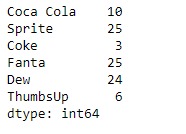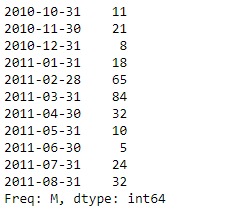Pandas 係列是帶有軸標簽的一維ndarray。標簽不必是唯一的,但必須是可哈希的類型。該對象同時支持基於整數和基於標簽的索引,並提供了許多方法來執行涉及索引的操作。
Pandas Series.kurt()函數使用Fisher的峰度定義(正常的峰度== 0.0)在請求的軸上返回無偏峰度。結果由N-1歸一化。
用法: Series.kurt(axis=None, skipna=None, level=None, numeric_only=None, **kwargs)
參數:
axis:要應用的函數的軸。
skipna:計算結果時排除NA /null值。
level:如果軸是MultiIndex(分層),則沿特定級別計數,並折疊成標量。
numeric_only:僅包括float,int,boolean列。
**kwargs:要傳遞給函數的其他關鍵字參數。
返回:kurt:標量或係列(如果指定級別)
範例1:采用Series.kurt()函數查找給定係列對象的基礎數據的峰度。
# importing pandas as pd
import pandas as pd
# Creating the Series
sr = pd.Series([10, 25, 3, 25, 24, 6])
# Create the Index
index_ = ['Coca Cola', 'Sprite', 'Coke', 'Fanta', 'Dew', 'ThumbsUp']
# set the index
sr.index = index_
# Print the series
print(sr)輸出:

現在我們將使用Series.kurt()函數查找給定係列對象的基礎數據的峰度。
# return kurtosis
result = sr.kurt()
# Print the result
print(result)輸出:

正如我們在輸出中看到的,Series.kurt()函數已返回給定係列對象的峰度。
範例2:采用Series.kurt()函數查找給定係列對象的基礎數據的峰度。
# importing pandas as pd
import pandas as pd
# Creating the Series
sr = pd.Series([11, 21, 8, 18, 65, 84, 32, 10, 5, 24, 32])
# Create the Index
index_ = pd.date_range('2010-10-09', periods = 11, freq ='M')
# set the index
sr.index = index_
# Print the series
print(sr)輸出:

現在我們將使用Series.kurt()函數查找給定係列對象的基礎數據的峰度。
# return kurtosis
result = sr.kurt()
# Print the result
print(result)輸出:

正如我們在輸出中看到的,Series.kurt()函數已返回給定係列對象的峰度。
相關用法
- Python pandas.map()用法及代碼示例
- Python Pandas Series.str.len()用法及代碼示例
- Python Pandas.factorize()用法及代碼示例
- Python Pandas TimedeltaIndex.name用法及代碼示例
- Python Pandas dataframe.ne()用法及代碼示例
- Python Pandas Series.between()用法及代碼示例
- Python Pandas DataFrame.where()用法及代碼示例
- Python Pandas Series.add()用法及代碼示例
- Python Pandas.pivot_table()用法及代碼示例
- Python Pandas Series.mod()用法及代碼示例
- Python Pandas Dataframe.at[ ]用法及代碼示例
- Python Pandas Dataframe.iat[ ]用法及代碼示例
- Python Pandas.pivot()用法及代碼示例
- Python Pandas dataframe.mul()用法及代碼示例
- Python Pandas.melt()用法及代碼示例
注:本文由純淨天空篩選整理自Shubham__Ranjan大神的英文原創作品 Python | Pandas Series.kurt()。非經特殊聲明,原始代碼版權歸原作者所有,本譯文未經允許或授權,請勿轉載或複製。
